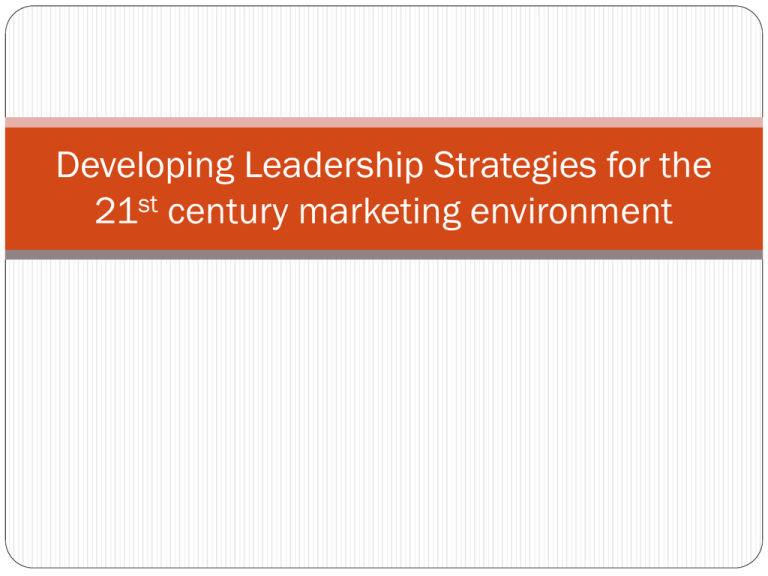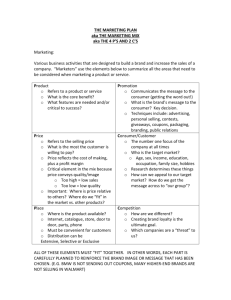Leader - CA Sri Lanka
advertisement

Developing Leadership Strategies for the 21st century marketing environment Who Are Leaders and What Is Leadership? Leader - Someone who can influence others and who has managerial authority. Leadership -What leaders do; the process of influencing a group to achieve goals. Ideally, all managers should be leaders. Seven Traits Associated with Leadership Contemporary Views of Leadership Transactional Leadership Leaders who guide or motivate their followers in the direction of established goals by clarifying role and task requirements. Transformational Leadership Leaders who inspire followers to transcend their own self- interests for the good of the organization by clarifying role and task requirements. Charismatic Leadership An enthusiastic, self-confident leader whose personality and actions influence people to behave in certain ways. Characteristics of charismatic leaders: Have a vision Are able to articulate the vision Are willing to take risks to achieve the vision Are sensitive to the environment and follower needs Exhibit behaviors that are out of the ordinary Visionary Leadership A leader who creates and articulates a realistic, credible, and attractive vision of the future that improves upon the present situation. Visionary leaders have the ability to: Explain the vision to others Express the vision not just verbally but through behavior Extend or apply the vision to different leadership contexts Cross-Cultural Leadership Managing Teams Group Development Forming stage - the first stage of group development in which people join the group and then define the group’s purpose, structure, and leadership Storming stage - the second stage of group development, characterized by intragroup conflict Norming stage - the third stage of group development, characterized by close relationships and cohesiveness. Performing stage - the fourth stage of group development when the group is fully functional and works on group task. Adjourning - the final stage of group development for temporary groups during which group members are concerned with wrapping up activities rather than task performance. Group structure Role - behavior patterns expected of someone occupying a given position in a social unit. Norms - standards or expectations that are accepted and shared by a group’s members. Groupthink - when a group exerts extensive pressure on an individual to align his or her opinion with that of others. Status - a prestige grading, position, or rank within a group. Social loafing - the tendency for individuals to expend less effort when working collectively than when working individually. Group cohesiveness - the degree to which group members are attracted to one another and share the group’s goals. Digital Marketing What is digital Process definition Finding the best way of achieving goals, normally promoting a brand or service, through electronic connected media. This could be online on the web, through specialist Internet applications, or through mobile phone applications (both network and Bluetooth connections). Role - behavior patterns expected of someone occupying a given position in a social unit. Norms - standards or expectations that are accepted and shared by a group’s members. Groupthink - when a group exerts extensive pressure on an individual to align his or her opinion with that of others. Digital Strategy The process of specifying an organization's vision, goals, opportunities and initiatives in order to maximize the business benefits of digital initiatives to the organization. Building a Digital Strategy Actualization Planning Presence: Measure of the brand’s social footprint Influence: Branded message adoption Perception: Emotional reaction to the brand Virility: People organically participating in conversations Resonance: Reaction to the overall conversation about the brand Creation Formulate the right message: After you have assessed your current position and taken stock of consumer sentiment and perception, it’s time to formulate your message. Choose the right platform:During the creation phase, you’ll decide what platforms and technology makes sense to leverage in your digital strategy. It's important to consider your audience, both in terms of age, geographic location, and lifestyle Actualization Build an Engagement Timeline: Create a calendar that shows your brand’s marketing efforts across the channels you are leveraging in your marketing programs. Use it for benchmarks related to your digital strategy. Consistency is Key: Keep your brand story and maintain the brand message across all channels so that current and future customers can connect with your company on a deeper level. Evaluation Utilize social listening tools to get insights into Campaign performance, variances in brand health, and language cues that are indicative of purchase intent and overall brand performance. Eg:Speed fast,Radian 6,Tweet reach E commerce Is a type of industry where The buying and selling of products or services is conducted over electronic systems such as the Internet and other computer networks. Electronic commerce Draws on technologies such as mobile commerce Social Media “A group of Internet-based applications that build on the ideological and technological foundations of Web 2.0, and that allow the creation and exchange of userAndreas Kaplan and Michael Haenlein generated content.” Social media depend on mobile and web-based technologies to create highly interactive platforms through which individuals and communities share, co-create, discuss, and modify usergenerated content





